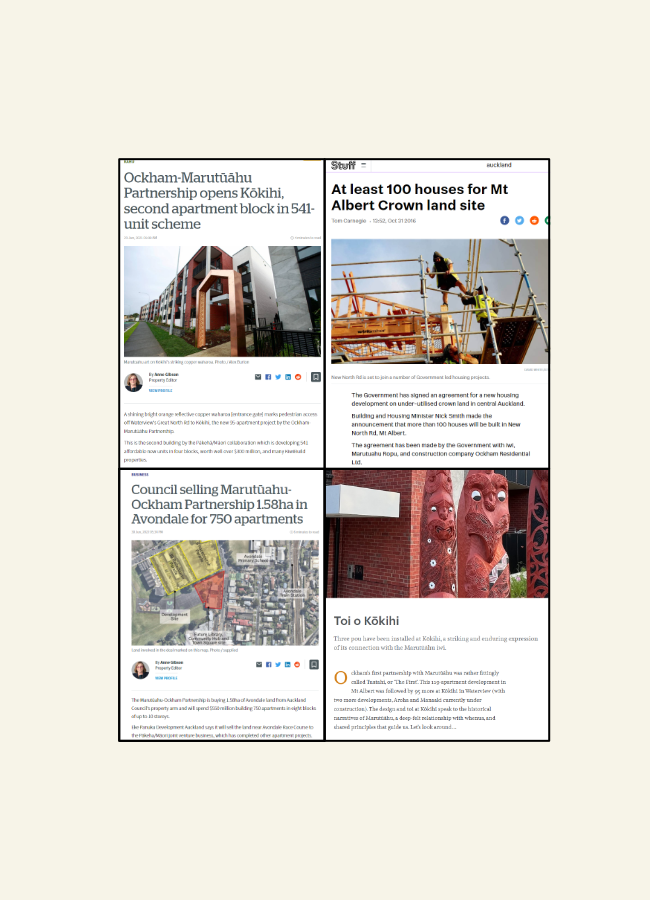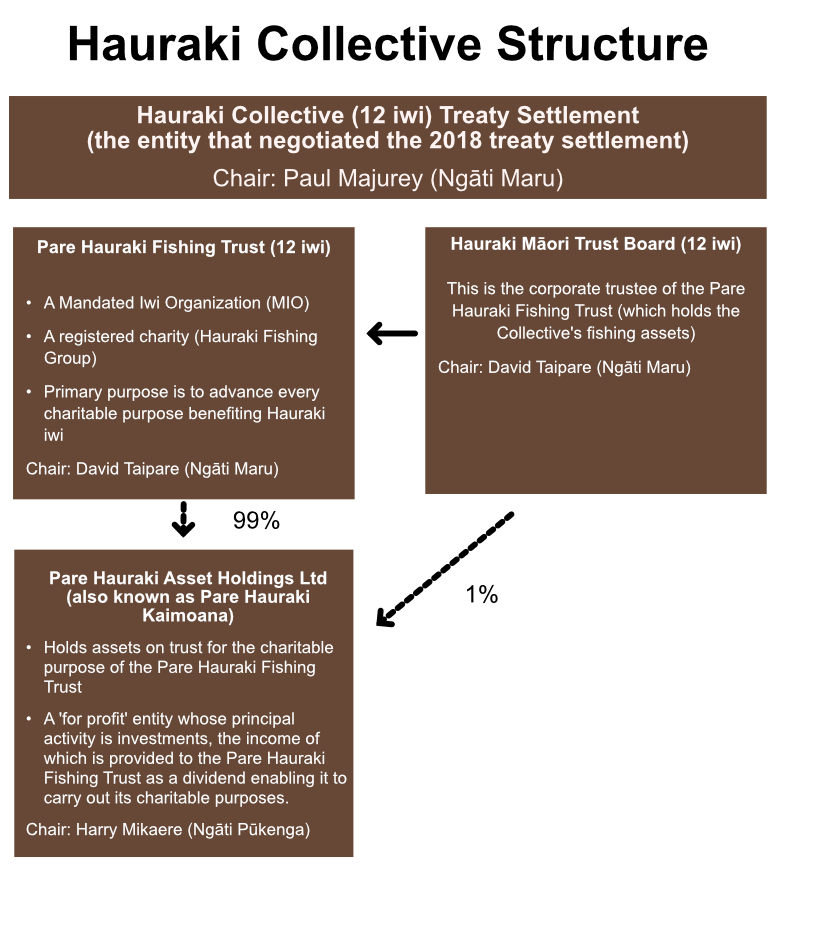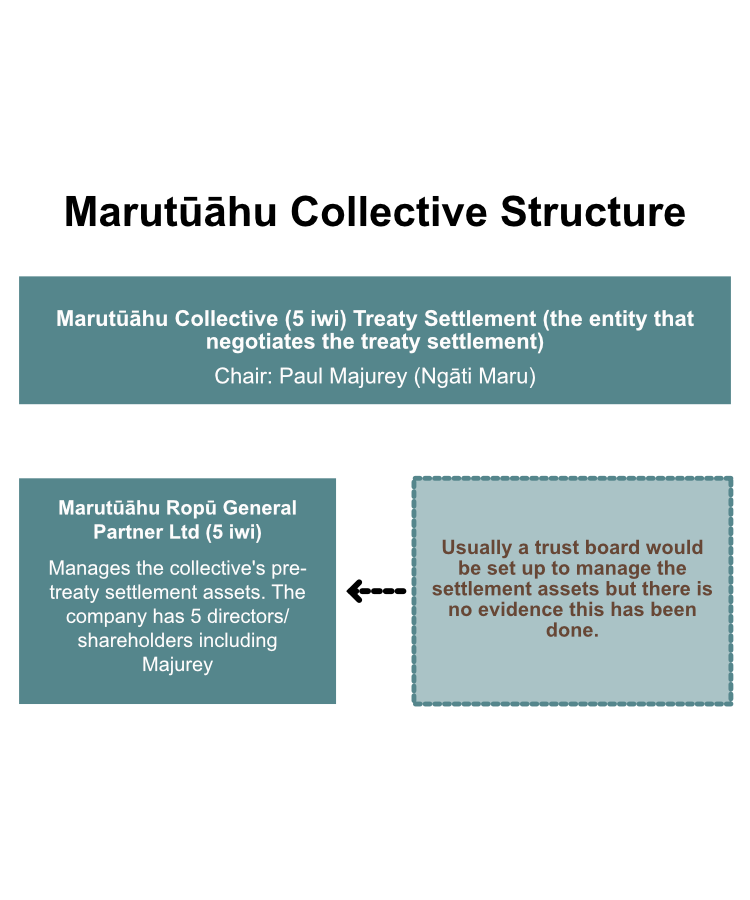
There’s something fishy going with Paul’s Marutūāhu Collective property deals with Ockham Residential. Read on to find out why…
As seen in this diagram, there are 5 steps to understanding our questions relating to the way Paul is using the Marutūahu Collective. Read on to find out more.

1. Understanding the Hauraki Collective and its treaty settlement status
The Hauraki Collective comprises 12 iwi, including the 5 iwi from the Marutūāhu Collective. However, the two collectives are completely separate entities.
The Hauraki Collective’s treaty settlement was finalised in 2018.
Paul Majurey chaired the entity that negotiated the iwi’s Treaty settlement, but he is not a member of any of the entities that manage the iwi’s assets.
However, it is him, rather than David Taipare or Harry Makaere, who is nearly always quoted in the media in relation to Hauraki iwi issues.

Step 2. Understanding the Marutūāhu Collective and its Treaty settlement status

The Marutūāhu treaty settlement was initialed in 2013 but never signed, due to some of the iwi having concerns that this is not the best course for them.
As a result, there is no iwi trust because no treaty assets have been distributed by the government. Sometimes the government will allocate assets in advance of a settlement (i.e. give them ‘on tick’) but, to the best of our knowledge, no assets have been advanced.
In any case, cash parts of the settlement would go directly to each iwi and not to the Marutūāhu Collective.
Marutūāhu Ropu General Partner Ltd’s five shareholders represent each iwi in the collective. However, iwi members are given no information about this entity’s finances or decisions made. Given the lack of progress on this settlement since 2013, we suspect it is a shell company at this stage, but don’t know for sure. Email us if you have any information.
Step 3. Understanding the Marutūāhu Collective construct and its strategic importance to Paul Majurey
The five Marutūāhu iwi all descend from the common ancestor Marutuahu. However, there is no credible historical reference to there being a Marutūāhu collective or confederation before the 1980s. Things were far more fluid before that time, with those iwi coming together for a common cause at times, while at war with each other at different times.
While the various Marutūāhu iwi came and went from the Auckland area over the centuries, only some of them can demonstrate “ahi ka roa” – continuous occupation of, and predominance over, specific parts of the Tamaki isthmus. This matters to Paul, because his iwi Ngati Maru has not been able to provide credible historic evidence of ahi ka roa (and therefore mana whenua status) in Auckland.
But that hasn’t stopped Paul and Ngati Maru from trying, including the outlandish claim that ahi ka roa was conferred via the Ngati Maru meeting house ‘Hotunui’ being in the Auckland War Memorial Museum! That’s why you’ll sometimes see photos of Paul by Hotunui in the many obsequious NZ Herald articles about him. Little does the naive Herald realize what an incredibly loaded statement that photo makes to Tamaki Makaurau’s genuine mana whenua iwi.
Paul has cleverly created the Marutuahu Collective construct to give him an “in” to Auckland off the back of Marutuahu iwi such as Ngati Paoa who can demonstrate strong and credible historic connections to Auckland.
Why This Matters
All of this smoke and mirrors is designed to give Paul a foothold in Auckland and a place at the decision-making table based on having ‘mana whenua’ status. Without that he can’t chair Tupuna Maunga Authority and his chairmanship of Auckland Council’s property development CCO Eke Panuku would be even more questionable than it already is.
And without having mana whenua status in Auckland, then neither Ngati Maru nor Paul can legitimately claim access to first rights of refusal on Crown and Auckland Council land for sale. And that’s what the big prize is – land. A love of Tamaki Makaurau’s maunga and motu almost certainly did not underpin Paul’s successful efforts to have Ngati Maru included in the Ngā Mana Whenua o Tāmaki Makaurau Collective Redress Act 2014. Instead, the glittering prize was access to the Right of First Refusal on all Crown and Auckland Council owned land that comes up for sale over a 172-year period, in the area bounded by Raglan to Miranda in the South, and Muriwai to Long Bay in the North.
Paul’s status as “mana whenua” off the back of the Marutūāhu “Collective” – no doubt helped in no small measure by Chairing Eke Panuku – has placed him and Ngati Maru very, very nicely to leverage the opportunitie$ arising.

Step 4. Unpicking what the Marutūāhu Ockham Residential partnership actually is
Now here’s where it starts to get really interesting and really rather curious – unpicking what the Marutūāhu Ockham partnership actually is.
In the two years between 2020 and 2022 a partnership between Ockham Residential and Marutūāhu announced they were entering at least $1 billion worth of residential property developments in Auckland. Yet Marutūāhu is not listed as a shareholder in any of the various Marutūāhu Ockham limited partnership entities shown in the NZ Companies Office’s Limited Partnership Register.
This begs the question of what Marutūāhu’s financial input is given the Collective hasn’t signed its treaty settlement. Furthermore, members of some iwi within the collective report they have not been told about their own iwi making any financial contributions towards these developments. So what is this partnership, how is it being bankrolled and who exactly is benefitting?
Interestingly, Pare Hauraki Fishing Trusts (PHFT) 2021 annual report lists investments in four Marutuahu Ockham entities as can be seen below. However, these investments are of a fairly minor nature in the context of those developments’ massive costs.
PHFT isn’t listed as a shareholder in any of the Marutūāhu-Ockham limited partnership entities. This suggests the ‘investment’ is not in the form of shares and that Pare Hauraki Fishing Trust could be bankrolling the projects in the form of unsecured, low or zero interest loans in return for a profit share. If that’s the case then it’s a high risk strategy!
Again, referring to the PHFT annual report (see image below right), the listing of these investments as “Marutūāhu Ockham” means that the Trustees of PHFT have agreed (even by omission) to ‘trading off’ Marutūāhu’s name. This seems odd.
So far as we can tell, there is nothing that appears to link to Marutuahu to the Ockham developments, other than its name. Even that seems tenuous, with the Marutūāhu references appearing to quietly disappear from the more recent Ockham developments’ marketing as time passes.

Step 5: Some questions around what’s not adding up
We’ve got a lot of questions about what’s not adding up with the Ockham Marutūāhu partnership. Contact us if you know the answers to any of the following:
1. Beyond the use of its name, what is Marutūāhu’s actual relationship with these Ockham Residential partnerships?
2. If the relationship is minimal or even non-existent, then why is the Marutūāhu name being used (rather than Pare Hauraki)? Is this just another way of Paul inserting Ngāti Maru and Hauraki iwi into Tamaki Makaurau by way of the Marutūāhu Collective Trojan Horse?
3. What is the status of money that Pare Hauraki is investing in the Marutūāhu-Ockham limited partnership entities given that PHFT is not a shareholder? Are these investments in the form of loans? If they are loans then are they secured? And is there a fixed interest rate of return? If they are not loans, then what form do these investments take and what is the risk profile?
4. Is Ockham “brown washing” its projects by making the iwi connection look more than what it actually is?
5. Is Ockham gaining access to Auckland land via Marutūāhu iwis’ access to the Tamaki Collective’s rights of first refusal on Crown and Auckland Council land coming up for sale?
6. Is Paul using his Auckland Council and Eke Panuku contacts to ‘smooth the way’ with the consenting process on the Ockham-Marutūāhu developments? In October 2022, Ngāti Whātua Ōrākei lodged a formal complaint to Auckland Council alleging just that. But they are not the only ones to have questioned Paul’s integrity in this respect. This formal complaint to Auckland Council over the removal of a listed macrocarpa tree (“Big Mac”) on the boundary of a Marutūāhu-Ockham development suggests further investigation is needed into this question. See below for an excerpt from that complaint.
7. How are the people of the five Marutūāhu iwi benefiting from the Marutūāhu-Ockham partnership? Is there any transparency around what it means for them financially (rhetorical question)?
See a media article that raises questions about Majurey’s involvement with Ockham.


Leave a comment